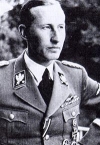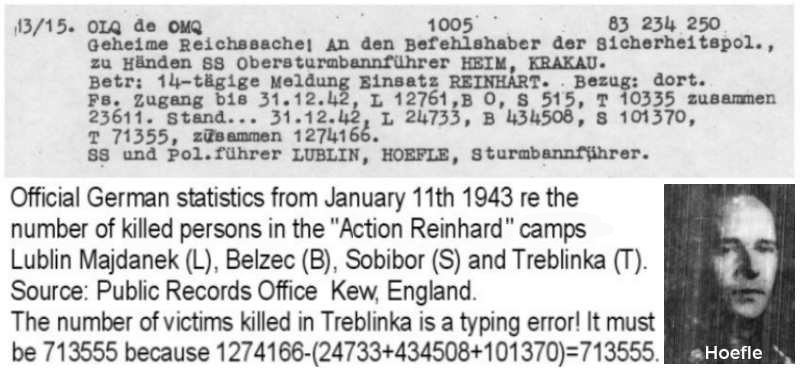 |
| Heydrich |
"
Einsatz Reinhard" - code name for the extermination of Polish Jewry in the former
Generalgouvernement
and the
Bialystok area, better known as "
Aktion Reinhard".
The
term was taken in remembrance of
SS-Obergruppenführer
Reinhard Heydrich, the coordinator of the
Endlösung der Judenfrage
(
Final Solution of the Jewish Question) - the extermination of the Jews
living in the European countries occupied by German troops during WW2. Members of the Czech underground resistance
fighters assassinated
Heydrich on
27 May 1942.
 |
Chain of
Command |
The head of
Aktion Reinhard was
SS-Brigadeführer
Odilo Globocnik, (SS- and police chief of the district
Lublin), appointed by
Heinrich Himmler.
SS-Sturmbannführer
Hermann Höfle, chief of
Hauptabteilung Reinhard (Main Department
Reinhard), was responsible for personnel and organization of deportations, extermination camps and realization of
the victims' valuables.
Polizei-Kriminalkommissar
Christian Wirth and his staff of
the euthanasia programme ("
Aktion T4") - experienced in killing innocent victims such as the mentally and
terminally ill - were not sent to the front but ordered to
Lublin and became the hard core in
the extermination camps in eastern Poland
(
Complete Staff of Germans and Austrians). The camp guards were recruited
from Soviet POWs, mainly Ukrainian and
Volksdeutsche
volunteer auxiliaries who were trained at the
Trawniki camp
near
Lublin. Those T4 men who had no basic military training because they were
police men, workers or male nurses, underwent this in
Trawniki.
Many of them were
promoted because of their atrocities in the death camps.
The
Aktion Reinhard headquarters were located in
Lublin, the construction department in
Zamosc. The clothes and belongings of the victims were stored and sorted in
Lublin
(
Chopin Street and at disused hangars of the
Lublin Airfield).
Starting from
1 November 1941
(
Timeline,
Time Table, and
Comparison of Dimensions),
three extermination camps were constructed to cope with the population of adjacent ghettos and
other victims from surrounding areas: first
Belzec, then
Sobibor, and finally
Treblinka. They were
located in the far east of Poland near the borders with Byelorussia and Ukraine. The camps
had to be located near main railway lines as victims were to be transported
by rail, and in sparsely populated areas because of secrecy.
As a guise the victims were told that they were being transported
(
Deportation Transports) east for resettlement and work.
The extermination process in
Belzec, Sobibor, and Treblinka was similar to the
"well-tried" method used in the six euthanasia killing centers in Germany and Austria:
Deception ("You must get a shower in the bathroom!").
Handing over the valuables (enrichment for the German
Reichsbank).
Undressing (realization of the clothings and finding of hidden jewelry).
Cooping up the victims in the gas chamber (as narrow as
possible to minimize the air volume).
Use of carbon monoxide gas (CO) (discharged through gaspipes).
Cremating the corpses (covering up all tracks).
The structure of all camps was nearly identical:
From the reception area with ramp and undressing barrack the Jews entered a narrow, camouflaged path
(called sluice or tube) to the extermination area with gas chambers, pits and cremation grids.
The SS and Trawnikis stayed in a separate area, the
Jewish work command too. Barbed wire fences, partially
camouflaged with pine branches, surrounded the camp and separated the different parts. Electric fences like
in
Auschwitz were not used. Wooden watchtowers completed the camp.
In course of
Aktion Reinhard approximately 2 Million Jews lost their lifes in
Belzec, Sobibor, Treblinka, and Majdanek. Jewish property to the value of 178,045,960
German
Reichsmark (todays value around 760,000,000 US$)
was robbed
and fell into the hands of German authorities but single persons too (SS and police men, camp guards,
non-Jewish inhabitants of towns and villages with ghettos or adjacent camps).
Aktion Reinhard Economics
Aktion Reinhard ended in
November 1943. After they finished their bloody
work in Poland, most of the men
were sent to northern Italy for actions against remaining Jews and partisans. Many of them turned up again
in the concentration camp
San Sabba near
Trieste. The group disintegrated after the surrender of the
German
Wehrmacht in Italy. See
Himmler's
thank-you letter to
Globocnik.
The Police State
What was known, what was done by the Allies
Aktion Reinhard and Historical Perspective
Aktion Reinhard PRO Decodes
Aktion Reinhard Economics
Globocnik's Staff in Lublin
The Nazi Police School in Rabka
Aktion Reinhard Books
Camp Songs and Music
© ARC 2005













